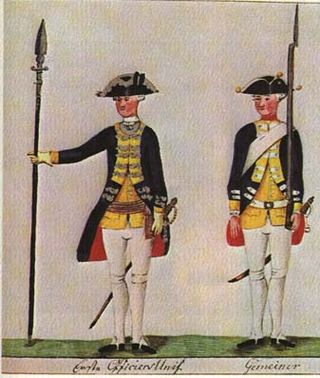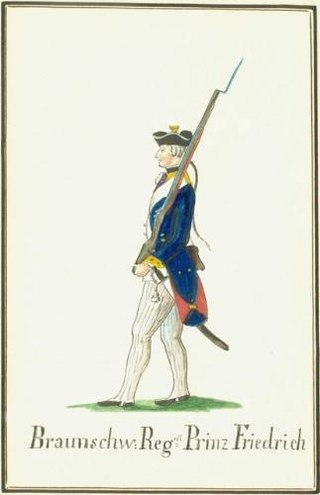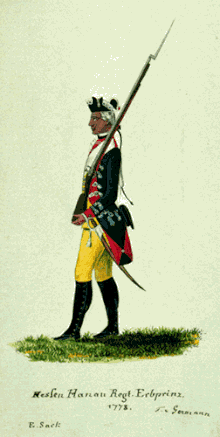A company is a military unit, typically consisting of 100–250 soldiers and usually commanded by a major or a captain. Most companies are formed of three to seven platoons, although the exact number may vary by country, unit type, and structure.

Hessians were German soldiers who served as auxiliaries to the British Army during several major wars in the 18th century including the American Revolutionary War. The term is a synecdoche for all Germans who fought on the British side, since 65% came from the German states of Hesse-Kassel and Hesse-Hanau. Known for their discipline and martial prowess, around 30,000 Germans fought for the British during the war, around 25% of British land forces.
The 8th Pennsylvania Regiment or Mackay's Battalion was an American infantry unit that became part of the Continental Army during the American Revolutionary War. Authorized for frontier defense in July 1776, the eight-company unit was originally called Mackay's Battalion after its commander, Colonel Aeneas Mackay. Transferred to the main army in November 1776, the unit was renamed the 8th Pennsylvania Regiment on 1 January 1777. It completed an epic winter march from western Pennsylvania to New Jersey, though Mackay and his second-in-command both died soon afterward. In March 1777 Colonel Daniel Brodhead assumed command. The regiment was engaged at the Battles of Bound Brook, Brandywine, Paoli, and Germantown in 1777. A body of riflemen were detached from the regiment and fought at Saratoga. Assigned to the Western Department in May 1778, the 8th Pennsylvania gained a ninth company before seeing action near Fort Laurens and in the Sullivan Expedition in 1778 and 1779. The regiment consolidated with the 2nd Pennsylvania Regiment in January 1781 and ceased to exist.

The 1st Continental Light Dragoons, also known as Bland's Horse, was a mounted regiment of the Continental Army organized between 13 June and 10 September 1776 in Williamsburg, Virginia. It was made up of men from eastern and northern Virginia for service with the Continental Army.
The 8th Virginia Regiment or German Regiment was an infantry unit that served in the Continental Army during the American Revolutionary War. Authorized in January 1776, the regiment was raised from men of several northwestern counties in the strength of 10 companies. Its first commander was Colonel Peter Muhlenberg, a clergyman and militia leader. The unit marched to defend Charleston, South Carolina in 1776, but saw no fighting. At the start of 1777, the 8th Virginia moved to join George Washington's main army. When Muhlenberg was promoted to general officer, Colonel Abraham Bowman took command of the unit.
Quartermaster sergeant (QMS) is a class of rank or appointment in some armed forces, especially those of the United Kingdom and the Commonwealth, and formerly also in the United States.
The northern theater of the American Revolutionary War also known as the Northern Department of the Continental Army was a theater of operations during the American Revolutionary War.

People of German ancestry fought on both sides in the American Revolution. Many of the small German states in Europe supported the British. King George III of Britain was simultaneously the ruler of the German state of Hanover. Around 30,000 Germans fought for the British during the war, around 25% of British land forces. In particular, 12,000 Hessian soldiers served as mercenaries on the side of British. However some European Germans as individuals crossed the Atlantic to help the Patriots, who were supporters of Congress.

The Battle of Trenton was fought on December 26, 1776, during the American Revolutionary War campaign for New Jersey. In a surprise attack, the Continental Army led by George Washington attacked the winter quarters of a brigade composed primarily of German troops from Hesse-Kassel in Trenton, New Jersey. The Hessian brigade was under the command of Colonel Johann Rall; he died of wounds sustained in the battle, and about two thirds of his men were taken prisoner. It was the first major victory after a long string of defeats that had resulted in the loss of New York City, and was a significant boost to American morale. It was followed by two more American victories, first in a second battle at Trenton on January 2, 1777, and then on January 3 at Princeton.
1st American Regiment, also known as Jackson's Continental Regiment of 1783–1784, was the last unit in the Continental Army, retained after the close of the American Revolutionary War. This regiment, under the command of Colonel Henry Jackson of Massachusetts, was not the same unit as Jackson's Additional Continental Regiment of 1777, which had become the 16th Massachusetts Regiment in 1780 and had been disbanded in 1781. Equally, this regiment should not be confused with the First American Regiment of 1784–1791, which was originally commanded by Colonel Josiah Harmar, has remained in service to the present, and is now the 3d United States Infantry Regiment.

At the Battle of Brandywine on September 11, 1777 a colonial American army led by General George Washington fought a British-Hessian army commanded by General William Howe, 5th Viscount Howe. Washington drew up his troops in a defensive position behind Brandywine Creek. Howe sent Lieutenant General Wilhelm von Knyphausen's 5,000 troops to demonstrate against the American front at Chadd's Ford. Meanwhile, Lieutenant General Charles Cornwallis took 10,000 troops on a wide flank march that crossed the creek and got in the rear of the American right wing under Major General John Sullivan. The Americans changed front but Howe's attack broke through.
Creuzbourg's Jäger Corps(Jäger-Corps von Creuzbourg) was an independent Jäger battalion raised by the county of Hesse-Hanau and put to the disposition of the British Crown, as part of the German Allied contingent during the American Revolutionary War. The corps fought at the Battle of Oriskany, although mostly serving as garrison of different Canadian posts.

Troops from Hesse-Hanau served as auxiliaries to the British Army during the American Revolutionary War, in accordance with the treaty of 1776 between Great Britain and the small principality. A regiment of foot, an artillery company, a ranger corp and a light infantry corp served in British America. A total of 2,422 soldiers were sent, with 1,441 returning, the remainder not surviving or choosing to remain in North America. As compensation, the reigning Count of Hesse-Hanau received a total of 343,110 pounds sterling from the British government.

Brunswick troops in the American Revolutionary War served as auxiliaries to the British Army during the American Revolutionary War, in accordance with the treaty of 1776 between Great Britain and the Principality of Brunswick-Wolfenbüttel. Four regiments of foot, one regiment of dragoons, one grenadier battalion, and one light battalion with a Jäger company were dispatched to British America. Most of the Brunswick troops fought at the Battles of Saratoga, where they were forced to surrender as part of British General John Burgoyne's army. A total of 5,723 soldiers were sent overseas, and 2,708 returned to Brunswick-Wolfenbüttel. Part of the difference can be attributed to casualties, but the rest chose to remain in the United States or Canada instead of returning to Europe. Over the course of the war, the British government paid the Prince of Brunswick-Wolfenbüttel a total of £750,000 for the use of his army.
North Carolina state troops in the American Revolution were the initial military units created in a transition from the Province of North Carolina under British rule to independence from British rule. Most units did not last long as such and were either transferred to the Continental Army or state militia instead.

Friedrich Wilhelm von Lossberg was a Hessian Lieutenant General fighting with the British-allied German contingents in the American Revolutionary War. He was sent to America in 1776 as a colonel commanding the First Brigade of the Second Hessian Division under Lieutenant General Wilhelm von Knyphausen. Von Knyphausen in turn was second in command under General Leopold Philip de Heister.
A regiment is a military unit that has been in use by the United States Army since its inception. Derived from the concept originating in European armies, a regiment was historically commanded by a colonel, and consisted of ten companies, for a total of approximately 1,000 soldiers. Confusingly, the terms "regiment" and "battalion" were used interchangeably at this time; it was not until later that a battalion was defined as a sub-unit of a regiment. The regiment fulfilled both administrative and tactical functions and was the principal maneuver unit of the US Army until being superseded in the 20th century by the division.
The 1919 King's Birthday Honours in New Zealand, celebrating the official birthday of King George V, were appointments made by the King on the recommendation of the New Zealand government to various orders and honours to reward and highlight good works by New Zealanders. They were announced on or dated 3 June 1919.








